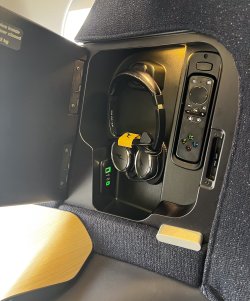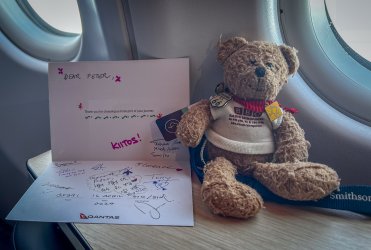Skyring
Established Member
- Joined
- Oct 18, 2005
- Posts
- 2,206
- Qantas
- LT Silver
My Qantas flight is a Finnair "wet lease", meaning it's Finnair equipment and crew but Qantas supplies including food, drink, amenity kits etc. The most talked-about feature of Finnair's product is the "no-recline" business seat.
Sounds odd but I think it works quite well. The seat itself is generously proportioned, at least in its sitting portion. There is a wide, curving backrest that doesn't move in any way, and a flat bed that is divided into two parts by two tilting panels. For normal sitting, these panels are rotated down for the passenger's feet to rest on the floor, and to lie flat, they swing up to form a continuous horizontal surface extending into a rather narrow footwell.
You want to lie down, just swing the panels up, move your bum forward, and lie down.
View attachment SYD-SIN Seat 02.jpg
View attachment SYD-SIN Seat 03.jpg
Looking at the thing, front to back, you get a tunnel for your legs. This is my main criticism of the seat, but it's not a huge one; the tunnel is a little cramped and rolling over from one side to the other could be a little difficult for side sleepers. The bulkhead seats have a more generous tunnel, so that's something to consider in seat selection.
For takeoff and landing, the bedding and spare pillows go in hear, quite out of the way because of course you are sitting up. For other times, if the seat is in the lie-flat configuration with the middle panels raised, best to spread out the bedding. The FA can do this.
For the Qantas wet-lease, mattress toppers are provided that fit the standard Qantas seat and not the Finnair seat. They are okay, just not optimum.
View attachment SYD-SIN Seat 04.jpg
Above the foot tunnel is a generously-sized flat touchscreen. This doesn't move but is fine for viewing either seated upright or lying flat. There is a controller provided for those with shorter arms but I found it a little fiddly and preferred, with my more simian arms, to touch the screen to select my preferred options.
The middle section of the seat has two panels that swing up and down to form the footwell for seated mode. The front panel is kind of skinny and is manually operated with a handle on the aisle side that needs to be pulled out and moved up or down as required. This can be a little awkward to reach and operate. For best results, get up and stand in the aisle.
Behind that is a powered panel that is operated by a button on the control strip that forms the side of the side armrest/work area,
Beside these two panels is a hinged lid for storage. Down, it forms part of the bed. Raised it reveals a good-sized storage department including a bin that will handle a full-sized laptop. Inflight magazines, safety cards, and menus go in here and there is heaps of room for other stuff. It becomes difficult but not impossible to reach under the bedding if you are in lie-flat mode.
There is also a circular well that holds a drink bottle.
Behind the footwell is the seat itself. This is where you put your bum when sitting and your head when lying. Probably best to ensure the bedding covers this region.
The backrest is tall and curved, providing a little privacy, especially when sleeping. All in all, this seat is extremely generous in its room and can be configured with pillows and cushions like a lounge. Small children can comfortably sit or lie down with their parents.
There is a side cushion topped by a blond wood (or wood-look) armrest that is large and flat and great for more storage. The top surface has a built-in charging panel with little rubber strips that hold your smartphone in place. There is a row of buttons to control lighting, footwell panel, and tray table.
Tray table is pushed out with a press of the button (and is spring-loaded when pushed back in) and can be unfolded to hold a meal tray, laptop, or whatever.
The footwell also has a universal AC outlet and USB port, along with lowlights to show where the bits are. This cannot be easily accessed with the seat in lie-flat mode, so best to plug your stuff in and ensure that nothing gets dislodged when raising the flap.
There are three seatbelts. A normal lap belt, a sash that attaches for takeoff and landing, and a sleep belt lower down.

As part of the backrest, another storage compartment is covered by a padded door. Open it up and you have headphone storage compartment and socket, a couple of USB ports, screen controller in its own little niche, and enough room for a couple of small items.
On the Finnair flights the entertainment system has a short film explaining how the seat works and another going into the design process. I found it to be an elegant, practical, and efficient design that is roomy where it counts. Because there is no need to accommodate motors and gears to move the seat up and down, nor room for these things to move, the passenger has access to all of that space.
The colour pallette is muted and restful.
I love it.
Sounds odd but I think it works quite well. The seat itself is generously proportioned, at least in its sitting portion. There is a wide, curving backrest that doesn't move in any way, and a flat bed that is divided into two parts by two tilting panels. For normal sitting, these panels are rotated down for the passenger's feet to rest on the floor, and to lie flat, they swing up to form a continuous horizontal surface extending into a rather narrow footwell.
You want to lie down, just swing the panels up, move your bum forward, and lie down.
View attachment SYD-SIN Seat 02.jpg
View attachment SYD-SIN Seat 03.jpg
Looking at the thing, front to back, you get a tunnel for your legs. This is my main criticism of the seat, but it's not a huge one; the tunnel is a little cramped and rolling over from one side to the other could be a little difficult for side sleepers. The bulkhead seats have a more generous tunnel, so that's something to consider in seat selection.
For takeoff and landing, the bedding and spare pillows go in hear, quite out of the way because of course you are sitting up. For other times, if the seat is in the lie-flat configuration with the middle panels raised, best to spread out the bedding. The FA can do this.
For the Qantas wet-lease, mattress toppers are provided that fit the standard Qantas seat and not the Finnair seat. They are okay, just not optimum.
View attachment SYD-SIN Seat 04.jpg
Above the foot tunnel is a generously-sized flat touchscreen. This doesn't move but is fine for viewing either seated upright or lying flat. There is a controller provided for those with shorter arms but I found it a little fiddly and preferred, with my more simian arms, to touch the screen to select my preferred options.
The middle section of the seat has two panels that swing up and down to form the footwell for seated mode. The front panel is kind of skinny and is manually operated with a handle on the aisle side that needs to be pulled out and moved up or down as required. This can be a little awkward to reach and operate. For best results, get up and stand in the aisle.
Behind that is a powered panel that is operated by a button on the control strip that forms the side of the side armrest/work area,
Beside these two panels is a hinged lid for storage. Down, it forms part of the bed. Raised it reveals a good-sized storage department including a bin that will handle a full-sized laptop. Inflight magazines, safety cards, and menus go in here and there is heaps of room for other stuff. It becomes difficult but not impossible to reach under the bedding if you are in lie-flat mode.
There is also a circular well that holds a drink bottle.
Behind the footwell is the seat itself. This is where you put your bum when sitting and your head when lying. Probably best to ensure the bedding covers this region.
The backrest is tall and curved, providing a little privacy, especially when sleeping. All in all, this seat is extremely generous in its room and can be configured with pillows and cushions like a lounge. Small children can comfortably sit or lie down with their parents.
There is a side cushion topped by a blond wood (or wood-look) armrest that is large and flat and great for more storage. The top surface has a built-in charging panel with little rubber strips that hold your smartphone in place. There is a row of buttons to control lighting, footwell panel, and tray table.
Tray table is pushed out with a press of the button (and is spring-loaded when pushed back in) and can be unfolded to hold a meal tray, laptop, or whatever.
The footwell also has a universal AC outlet and USB port, along with lowlights to show where the bits are. This cannot be easily accessed with the seat in lie-flat mode, so best to plug your stuff in and ensure that nothing gets dislodged when raising the flap.
There are three seatbelts. A normal lap belt, a sash that attaches for takeoff and landing, and a sleep belt lower down.

As part of the backrest, another storage compartment is covered by a padded door. Open it up and you have headphone storage compartment and socket, a couple of USB ports, screen controller in its own little niche, and enough room for a couple of small items.
On the Finnair flights the entertainment system has a short film explaining how the seat works and another going into the design process. I found it to be an elegant, practical, and efficient design that is roomy where it counts. Because there is no need to accommodate motors and gears to move the seat up and down, nor room for these things to move, the passenger has access to all of that space.
The colour pallette is muted and restful.
I love it.


























































